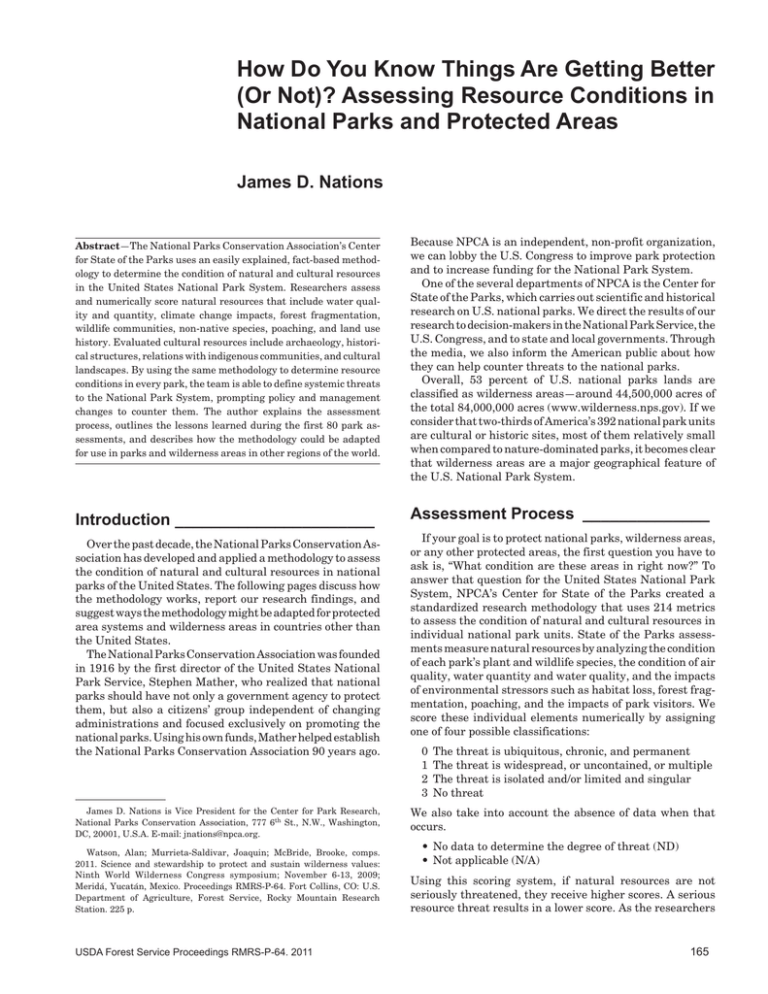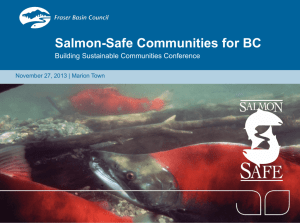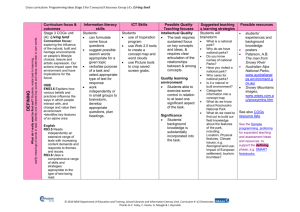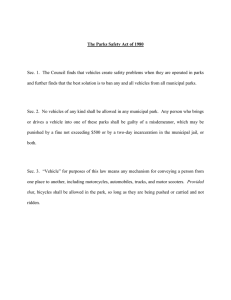How Do You Know Things Are Getting Better
advertisement

How Do You Know Things Are Getting Better (Or Not)? Assessing Resource Conditions in National Parks and Protected Areas James D. Nations Abstract—The National Parks Conservation Association’s Center for State of the Parks uses an easily explained, fact-based methodology to determine the condition of natural and cultural resources in the United States National Park System. Researchers assess and numerically score natural resources that include water quality and quantity, climate change impacts, forest fragmentation, wildlife communities, non-native species, poaching, and land use history. Evaluated cultural resources include archaeology, historical structures, relations with indigenous communities, and cultural landscapes. By using the same methodology to determine resource conditions in every park, the team is able to define systemic threats to the National Park System, prompting policy and management changes to counter them. The author explains the assessment process, outlines the lessons learned during the first 80 park assessments, and describes how the methodology could be adapted for use in parks and wilderness areas in other regions of the world. Introduction_______________________ Over the past decade, the National Parks Conservation Association has developed and applied a methodology to assess the condition of natural and cultural resources in national parks of the United States. The following pages discuss how the methodology works, report our research findings, and suggest ways the methodology might be adapted for protected area systems and wilderness areas in countries other than the United States. The National Parks Conservation Association was founded in 1916 by the first director of the United States National Park Service, Stephen Mather, who realized that national parks should have not only a government agency to protect them, but also a citizens’ group independent of changing administrations and focused exclusively on promoting the national parks. Using his own funds, Mather helped establish the National Parks Conservation Association 90 years ago. James D. Nations is Vice President for the Center for Park Research, National Parks Conservation Association, 777 6th St., N.W., Washington, DC, 20001, U.S.A. E-mail: jnations@npca.org. Watson, Alan; Murrieta-Saldivar, Joaquin; McBride, Brooke, comps. 2011. Science and stewardship to protect and sustain wilderness values: Ninth World Wilderness Congress symposium; November 6-13, 2009; Meridá, Yucatán, Mexico. Proceedings RMRS-P-64. Fort Collins, CO: U.S. Department of Agriculture, Forest Service, Rocky Mountain Research Station. 225 p. USDA Forest Service Proceedings RMRS-P-64. 2011 Because NPCA is an independent, non-profit organization, we can lobby the U.S. Congress to improve park protection and to increase funding for the National Park System. One of the several departments of NPCA is the Center for State of the Parks, which carries out scientific and historical research on U.S. national parks. We direct the results of our research to decision-makers in the National Park Service, the U.S. Congress, and to state and local governments. Through the media, we also inform the American public about how they can help counter threats to the national parks. Overall, 53 percent of U.S. national parks lands are classified as wilderness areas—around 44,500,000 acres of the total 84,000,000 acres (www.wilderness.nps.gov). If we consider that two-thirds of America’s 392 national park units are cultural or historic sites, most of them relatively small when compared to nature-dominated parks, it becomes clear that wilderness areas are a major geographical feature of the U.S. National Park System. Assessment Process_______________ If your goal is to protect national parks, wilderness areas, or any other protected areas, the first question you have to ask is, “What condition are these areas in right now?” To answer that question for the United States National Park System, NPCA’s Center for State of the Parks created a standardized research methodology that uses 214 metrics to assess the condition of natural and cultural resources in individual national park units. State of the Parks assessments measure natural resources by analyzing the condition of each park’s plant and wildlife species, the condition of air quality, water quantity and water quality, and the impacts of environmental stressors such as habitat loss, forest fragmentation, poaching, and the impacts of park visitors. We score these individual elements numerically by assigning one of four possible classifications: 0 The threat is ubiquitous, chronic, and permanent 1 The threat is widespread, or uncontained, or multiple 2 The threat is isolated and/or limited and singular 3 No threat We also take into account the absence of data when that occurs. • No data to determine the degree of threat (ND) • Not applicable (N/A) Using this scoring system, if natural resources are not seriously threatened, they receive higher scores. A serious resource threat results in a lower score. As the researchers 165 Nations How Do You Know Things Are Getting Better (Or Not)? Assessing Resource Conditions in National Parks and Protected Areas roll up the individual scores into subcategories and then into an overall rating, they establish a composite score for the park’s natural resources that can be labeled critical, poor, fair, good, or excellent. The methodology for cultural resources operates in much the same fashion, looking at factors such as the condition of historic structures and the extent of archaeological research. We also evaluate the park’s relationship with living tribal communities or traditional populations in or around the park. We score cultural resources on a finer numerical scale of 0 to 10, but at the end of the analysis, the park’s cultural resources also receive an overall classification of critical, poor, fair, good, or excellent. Our resource assessments are carried out by a team of NPCA ecologists and historians, or by ecologists and historians we hire for specific studies. The researchers interview National Park Service staff, analyze scientific reports, read the parks’ resource reports, and walk the ground with park staff to view resource conditions on the ground. The resulting reports identify threats and provide a baseline analysis that allows the park staff and other researchers to track changes through time. We begin each park resource assessment with a workshop with park staff and the NPCA research team. During the workshop, the park staff discusses the threats the park is facing, and they point the researchers to publications and information that will aid them in documenting resource conditions and threats. Following the workshop, the NPCA researchers spend four months or more absorbing material provided by park staff and university researchers, researching published scientific and historical literature, and talking with specialists in universities or park friends groups. The NPCA researchers complete two detailed technical studies—one on natural resources, one on cultural resources— that may be 25 to 70 typed pages long. Working with the original field researchers, staff at NPCA’s Center for State of the Parks then use the two technical studies to produce numerical scores for each of the resource metrics. The key point here is that rigorous analysis underlies the simple scoring system and resulting findings. The Center’s writers and editors subsequently merge the two technical studies into a shorter, final report (called a public document), which is designed to provide a concise overview of the park’s resource conditions for political decision-makers and the general public. We print the finalized public documents with maps and photographs in bound booklets and distribute them to the U.S. Congress, the National Park Service, and local communities and politicians. NPCA’s communications team works with newspaper, radio, and television journalists to place stories about the parks in regional and national media. The raw data from the assessments are stored in the Center for State of the Parks field office in Fort Collins, Colorado. The resulting database allows us to analyze the condition of park resources by region, by type of ecosystem, and by the frequency and severity of threats reported. Findings__________________________ By Fall 2009, the Center for State of the Parks team had completed resource assessments for 80 of the 392 units of the National Park System. This represents a 20 percent sample 166 of all national park units in the United States. The 80 park units do not form a random sample, but a representative sample based on balancing the type of park unit (national seashore, national battlefield, national historic sites), visitation numbers, geographic location, ecosystem type, and the period of history represented. Because we use the same methodology and the same questions to evaluate resource conditions in all park units, we can survey data from the individual park reports to obtain an estimate of resource conditions in the National Park System as a whole. This undertaking is the first ever system-wide field assessment of U.S. national parks, based on actual ground level data. Based on the combined information from the 80 individual park assessments we’ve completed, we are beginning to get a composite picture of the most serious threats in the U.S. National Park System. According to this analysis, the five most serious threats to natural resources and cultural resources are as follows: Natural Resources (n = 59 parks) 1. Habitat loss and/or loss of species 2. Non-native plant species 3. Adjacent land development (oil, gas, logging, mining) 4. Fragmentation of habitat (roads, previous land use) 5. Water contamination Cultural Resources (n = 77 parks) 1. Gaps in research and documentation of cultural resources 2. Incomplete archaeological surveys 3. Insufficient funding and staff to protect cultural resources 4. Inadequate preservation of historic structures 5. Inadequate museum/archival storage One of our major conclusions is that the staff of the U.S. National Park Service, while working diligently to hold the line against resource loss, are limited in how much they can achieve due to finite funding and staffing. There are not enough park staff as desired by many parks to combat invasive species, fix land use abuses that predate establishment of the parks, provide law enforcement and maintenance, and interpret the parks for visitors. For example, some historic structures in the parks are deteriorating due to inadequate funding to repair them and limitations on staff to protect them from the elements. Structures like the historic Spanish mission of San Antonio Missions National Historical Park in San Antonio, Texas, are cracking and falling into disrepair, a future that could be changed with additional funding and workers to maintain them. Some of the problems that U.S. national parks face can be solved through increased funding and additional staff, and NPCA continuously lobbies Congress to provide these. The need for funding is especially crucial for cultural resources, where the application of added funding and staff could begin to show results very quickly. At the same time, an increasing number of serious threats to America’s parks cross into park boundaries from the outside world. Invasive, non-native species, air and water pollution, and climate disruption are threatening natural ecosystems in the parks and damaging the visitor experience. U.S. national parks are increasingly threatened by the development of adjacent lands for oil and gas development, USDA Forest Service Proceedings RMRS-P-64. 2011 How Do You Know Things Are Getting Better (Or Not)? Assessing Resource Conditions in National Parks and Protected Areas mining, housing and commercial development, and even landfills. As an example, the territorial outline of Olympic National Park in Washington State (95 percent of which is declared wilderness area) is clearly visible from the space shuttle, because the adjacent national forest lands have been clearcut flush with the park’s legal boundary, leading to the degradation of native forest along the edges and changes in the prevalence of some wildlife species within the park. NPCA’s research indicates that almost half of our national park units have experienced a loss of habitat and the elimination of one or more animal species. Most of these parks have lost a key species or top predator, such as wolves or mountain lions. While some native species are declining, other species are becoming too numerous, and their overpopulation threatens entire park ecosystems. For lack of natural predators such as wolves, populations of native white-tailed deer are out of hand in many eastern parks. In Rocky Mountain National Park in Colorado, native elk roam the park at will and overgraze the ecosystem without fear of their natural predator, the wolf. Invasions of non-native species are damaging park ecosystems by killing or displacing native plants and animals. Seven million acres of parkland have been invaded by nonnative species, especially Asian insects and African grasses. Hemlock woolly adelgids, non-native pests originally from Japan, are killing thousands of hemlock trees in Shenandoah National Park and Great Smoky Mountains National Park, much the way the chestnut blight wiped out between three and four billion chestnut trees in America’s eastern forests during the early 20th century. Controlling non-native species in our national parks is partly a function of preventing potentially invasive plants and animals from entering the country. But once the organisms exist within our boundaries, controlling them is a function of park staff and money. Systemic Problems A 1999 study of the 89 terrestrial ecoregions of the United States found that only 52 percent were well represented within the National Park System (Sierra Club 1999). Some of the missing ecological regions are protected in National Forests or National Wildlife Reserves, but this implies that protection might be increased through cooperation among these agencies. Since 2001, only a handful of new park areas have been added to the National Park System—most of them small units representing important historic events. In the face of climate disruption, we also need to create biological corridors. We have been effective at preserving park boundaries, but as climate change shifts plant and wildlife habitat, organisms are beginning to move upward and northward. We need to know where they will likely go, who owns the land there, and what needs to be done to ensure they survive. Creating corridors and connectivity between protected areas is an effective adaptation to this problem. Conclusions_______________________ The bottom line is that adequately funding and staffing the National Park System will help solve many of the USDA Forest Service Proceedings RMRS-P-64. 2011 Nations c­ urrent and future threats facing America’s national parks— for example, shoring up historic structures, controlling invasive species, and preventing poaching and vandalism. But solving the problems that enter the national parks from the outside world requires not just funding for research and staff, but also years of policy work and education. It requires a paradigm shift in park relations with neighbors and with society at large. Our goal within the Center for State of the Parks and NPCA in general is to help supply the information and education that can help create that needed change. In a nutshell, studying the condition of natural and cultural resources in a national protected area system allows us to establish priorities for addressing the most serious threat, deciding which parks to focus on, and deciding what needs to be done first. A 2008 global study by the University of Queensland, Australia, and the United Nations Environmental Program World Conservation Monitoring Centre discovered 40 different methodologies in use for assessing the effectiveness of protected areas (UNEP 2009). Of these 40 programs, only six included cultural resources as well as natural resources. This is disconcerting, considering the growing number of World Heritage Sites and the need to monitor and protect the planet’s globally significant cultural sites as well as natural areas. NPCA’s Center for State of the Parks methodology was the only one of the 40 studies focused on the U.S. National Park System, which is the largest and best-funded of the park systems on the planet. Our study indicates that, despite the fact that the U.S. park system is the best funded protected area system in the world, insufficient staff and funding are the most frequently reported threats to U.S. National Parks. Personal experiences and reports from colleagues around the world lead us to believe that lack of staffing and funding is also one of the most common problems in the rest of the world’s protected areas. Ironically, the U.S. National Park Service budget—in Fiscal Year 2009, around $2.9 billion—is almost as much as the total amount of government spending on protected areas in the rest of the world—$3.2 billion (Martin 2004). Under its newly elected administration, the U.S. is gradually ramping up the amount of funding going into the National Park System, adding more than $100 million additional dollars per year. So the message is that persistence pays off. Having solid data to back up your calls for additional funding and staffing helps build your case; and knowing what the priority threats are to protected areas and protected area systems can help you use new funding wisely. What are the lessons we’ve learned in carrying out resource assessments of 80 U.S. national park units? • Most parks like having their story told to the outside world and appreciate being able to provide feedback on that story, but park staff don’t like being graded and don’t like being scored. • Staff at smaller parks appreciate having someone pay attention to them, while staff at larger parks complain that the resource assessments take too much time. • Park staff in some park units point out that they appreciate being brought together to talk with one another about resource issues, something they otherwise don’t always have time to do. • A park’s budget—and the Park System’s budget—is the key factor in resource protection. Even invasive species can be controlled with sufficient money and staff. 167 Nations How Do You Know Things Are Getting Better (Or Not)? Assessing Resource Conditions in National Parks and Protected Areas What lessons have we learned that might be of use in other countries? • Keep the methodology as simple as possible, while remaining scientifically accurate. • Communicate with park staff and involve them in the development of the methodology and process. • Explain the linkages between threats, trends, and constraints, rather than just the final scores. Park specialists will appreciate seeing the big picture. • Make the evaluation process clear and transparent. • Communicate your findings. • Make clear, concrete recommendations. • Use a standardized methodology that allows you to compare parks and build a picture of the park system as a whole. 168 Given these lessons learned, we invite researchers from other countries to examine the complete methodology on our website and adapt it, cannibalize it, or change it to fit the needs of your parks and wilderness areas. To examine the complete methodology, go to npca.org/stateoftheparks. References________________________ Martin, C. 2004. It pays to invest in the environment. Straits Times. February 16. Hong Kong. Sierra Club. 1999. Gap analysis: national park system. Washington, DC: The Sierra Club. United Nations Environmental Programme (UNEP). 2009. World Conservation Monitoring Centre: Data Bases. Available: www. unep-wcmc.org [2009, December 11]. USDA Forest Service Proceedings RMRS-P-64. 2011






